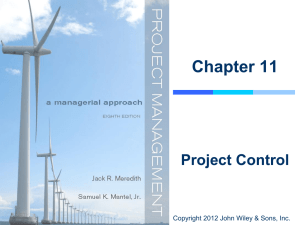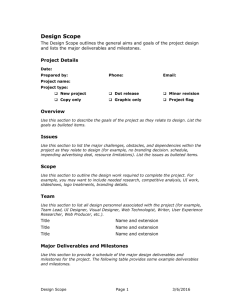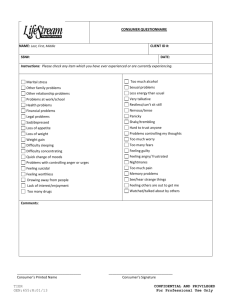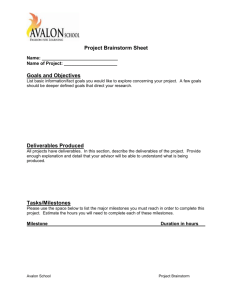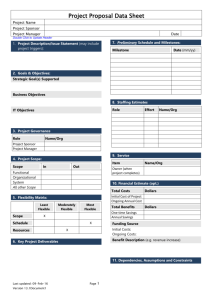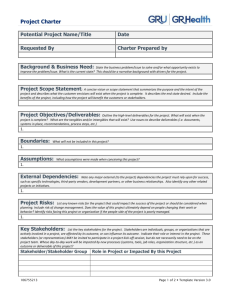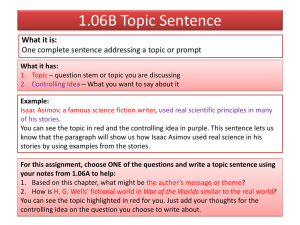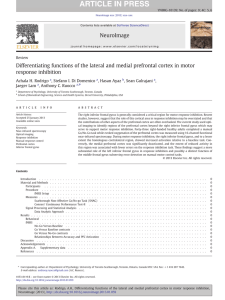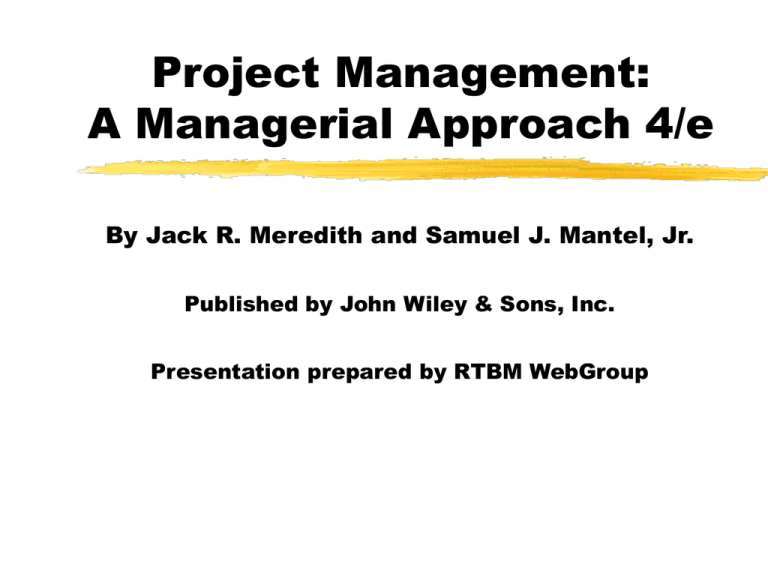
Project Management:
A Managerial Approach 4/e
By Jack R. Meredith and Samuel J. Mantel, Jr.
Published by John Wiley & Sons, Inc.
Presentation prepared by RTBM WebGroup
Project Management
A Managerial Approach
Chapter 11
Project Control
Project Control
Control is the last element in the
implementation cycle of planningmonitoring-controlling
Control is focused on three elements of a
project
Performance
Cost
Time
Chapter 11-1
Controlling Performance
There are several things that can cause a
project’s performance to require control:
Unexpected technical problems arise
Insufficient resources are available when needed
Insurmountable technical difficulties are present
Quality or reliability problems occur
Client requires changes in specifications
Interfunctional complications arise
Technological breakthroughs affect the project
Chapter 11-2
Controlling Cost
There are several things that can cause a
project’s cost to require control:
Technical difficulties require more resources
The scope of the work increase
Initial bids were too low
Reporting was poor or untimely
Budgeting was inadequate
Corrective control was not exercised in time
Input price changes occurred
Chapter 11-3
Controlling Time
There are several things that can cause a project’s
schedule to require control:
Technical difficulties took longer than planned to resolve
Initial time estimates were optimistic
Task sequencing was incorrect
Required inputs of material, personnel, or equipment
were unavailable when needed
Necessary preceding tasks were incomplete
Customer generated change orders required rework
Governmental regulations were altered
Chapter 11-4
Purposes of Control
There are two fundamental objectives of control:
1. The regulation of results through the alteration of
activities
2. The stewardship of organizational assets
The project manager needs to be equally attentive
to both regulation and conservation
The project manager must guard the physical
assets of the organization, its human resources,
and its financial resources
Chapter 11-5
Physical Asset Control
Requires control of the use of physical assets
Concerned with asset maintenance, whether preventive or
corrective
Also the timing of maintenance or replacement as well as
the quality of maintenance
Setting up maintenance schedules in such a way as to
keep the equipment in operating condition while
minimizing interference to ongoing work
Physical inventory whether equipment or material must
also be controlled
Chapter 11-6
Human Resource Control
Stewardship of human resources requires
controlling and maintaining the growth and
development of people
Projects provide fertile ground for cultivating
people
Because projects are unique, it is possible
for people working on projects to gain a
wide range of experience in a reasonably
short period of time
Chapter 11-7
Financial Resource Control
The techniques of financial control, both
conservation and regulation, are well known:
Current asset controls
Project budgets
Capital investment controls
These controls are exercised through a series
of analyses and audits conducted by the
accounting/controller function
Chapter 11-8
Financial Resource Control
Representation of the accounting/controlling
function on the project team is mandatory
The parent organization is responsible for the
conservation and proper use of resources owned
by the client or charged to the client
Due diligence requires that the organization
proposing a project conduct a reasonable
investigation, verification, and disclosure of all
material facts relevant to the firm’s ability to
conduct the project
Chapter 11-9
Three Types of Control
Processes
Decisions must be made concerning:
At what points in the project will control be
exerted
What is to be controlled
How it will be measured
How much deviation will be tolerated
How to spot and correct potential deviations
before they occur
Chapter 11-10
Three Types of Control
Processes
No matter what the purpose in controlling a
project there are two basic types of control
mechanisms that can be used:
Go/no-go control
Post control
Cybernetic control is a third, but less
common control mechanism that is rarely
directly applicable to projects.
Chapter 11-11
Go/No-go Controls
Take the form of testing to see if some specific
precondition has been met
Most of the control in project management falls
into this category
This type of control can be used on almost every
aspect of a project
Must exercise judgment in the use of go/no-go
controls
Go/no-go controls operate only when and if the
controller uses them
Chapter 11-12
Information Requirements
for Go/no-go Controls
The project proposal, plans specifications,
schedules and budgets contain all the information
needed to apply go/no-go controls to the project
Milestones are the key events that serve as a focus
for ongoing control activity
These milestones are the project’s deliverables in
the form of in-process output or final output
Chapter 11-13
Postcontrol
Postcontrols are applied after the fact
Directed toward improving the chances for future
projects to meet their goals
It is applied through a relatively formal document
that contains four distinct sections:
The project objectives
Milestones, checkpoints, and budgets
The final report on project
Recommendations for performance and process
improvement
Chapter 11-14
Characteristics of a
Control System
A good control system:
Should be flexible
Should be cost effective
Must be truly useful
Must satisfy the real needs of the project
Must operate in a timely manner
Sensors and monitors should be sufficiently accurate and
precise to control the project within the limits that are
functional for the client and parent organization
Chapter 11-15
Characteristics of a
Control System
A good control system (cont.):
Should
Should
Should
altered
Should
be as simple as possible
be easy to maintain
be capable of being extended or otherwise
be fully documented when installed
the documentation should include a complete training
program in system operation
Chapter 11-16
Control Systems
All control systems use feedback as a control
process
The control of performance, cost, and time usually
require different input data:
Performance - engineering change notices, test results,
quality checks, rework tickets, scrap rates
Cost - budgets to actual cash flows, purchase orders,
absenteeism, income reports, labor hour charges,
accounting variance reports
Schedule - benchmark reports, status reports, PERT/CPM
networks, earned value graphs, Gantt charts, WBS, and
action plans
Chapter 11-17
Control Tools
Some of the most important tools available for the
project manager to use in controlling the project
are variance analysis and trend projection
A budget plan or expected growth curve of time or
cost for a certain task is plotted
Actual values are plotted as a dashed line as the
work is actually finished
At each point in time a new projection from the
actual data is used to forecast what will occur in
the future
Chapter 11-18
Control Tools
Trend projection
Chapter 11-19
Critical Ratio Control
Charts
The critical ratio is made up of two parts:
The ratio of actual progress to scheduled progress
The ratio of budgeted cost to actual cost
The critical ratio is a good measure of the general
health of the project
By combining two ratios, it weighs them equally,
allowing a “bad” ratio to be offset by a “good”
ratio
Chapter 11-20
Critical Ratio
Task
Actual
Scheduled
Budgeted
Actual
Critcal
Number
Progress
Progress
Cost
Cost
Ratio
1
(2
/
3)
X
(6
/
4)
=
1.0
2
(2
/
3)
X
(6
/
6)
=
.67
3
(3
/
3)
X
(4
/
6)
=
.67
4
(3
/
2)
X
(6
/
6)
=
1.5
5
(3
/
3)
X
(6
/
4)
=
1.5
Chapter 11-21
Critical Ratio
Critical ratio control chart
Chapter 11-22
Benchmarking
A recent addition to the arsenal of of project
control tools is benchmarking
Benchmarking makes comparisons to “best in
class” practices across organizations
Some successful organizations have been
benchmarked on their best practices and key
success factors for projects being conducted
in functional organizations
Chapter 11-23
Best Practices and Keys to
Success
There were four major areas found to help
projects in functional organizations:
Promoting the benefits of project management
Personnel pay for project management skills
and high risk projects through bonuses, stock
options, and other incentives
Methodology
Results of project management
Chapter 11-24
Control as a Function of
Management
The purpose of controlling is always the same: to
bring the actual schedule, budget, and
deliverables of the project into reasonably close
congruence with the planned schedule, budget,
and deliverables
The job of the project manager is to set controls
that will encourage those behaviors that are
deemed desirable and discourage those that are
not
Chapter 11-25
Cybernetic Controls
Human response to steering controls tends to
be positive
Steering controls are usually viewed as helpful
rather than a source of unwelcome pressure
Response to steering controls also depends on
the acceptance that the goals of the control
system are appropriate
Chapter 11-26
Go/No-go Controls
Response to go/no-go controls tends to be
neutral or negative
“Barely good enough” results are just as
acceptable as “perfect” results
The system makes it difficult for the worker to
take pride in high quality work because the
system does not recognize gradations of quality
The fact that this kind of control emphasizes
“good enough” performance is no excuse for the
nonchalant application of careless standards
Chapter 11-27
Postcontrols
Postcontrols are seen as much the same as a
report card
They may serve as the basis for reward or
punishment, but they are received too late to
change current performance
Because postcontrols are placed on the process of
conducting a project, they may be applied to such
areas as: communication, cooperation, quality of
project management, and the nature of interaction
with the client
Chapter 11-28
Balance in a Control
System
General features of a balanced control system:
Built with cognizance of the fact that investment in
control is subject to sharply diminishing returns
Recognizes that as control increases past some point,
innovative activity is more and more damped, and then
finally shut off completely
Directed toward the correction of error rather than
toward punishment
Exerts control only to the degree required to achieve its
objectives
Utilizes the lowest degree of hassle consistent with
Chapter 11-29
accomplishing its goals
Control of Creative
Activities
The more creativity involved, the greater the
degree of uncertainty surrounding outcomes
Too much control tends to inhibit creativity
Control is not necessarily the enemy of creativity,
nor does creative activity imply complete
uncertainty of
There are three general approaches to control
creative projects:
Progress review
Personnel reassignment
Control of input resources
Chapter 11-30
Progress Review
The progress review focuses on the process of
reaching outcomes rather than on the outcomes
per se
The process is controllable even if the precise
results are not
Control should be instituted at each project
milestone
The object of control is to ensure that the
research design is sound and is being carried out
as planned or amended
Chapter 11-31
Personnel Reassignment
This type of control is straightforward individuals who are productive are kept
Those who are not, are moved to other jobs or
to other organizations
While it is not difficult to identify those who fall
in the top and bottom quartiles, it is usually
quite hard to make clear distinctions between
the people in the middle quartiles
Chapter 11-32
Control of Input Resources
The focus is on efficiency
The ability to manipulate input resources carries
with it considerable control over output
Considerable resource expenditure may occur
with no visible results, but suddenly many
outcomes may be delivered
The milestones for application of resource control
must be chosen with great care
Chapter 11-33
Control of Change and
Scope Creep
Coping with changes and changing priorities is
perceived as the most important single problem
facing the project manager
The most common changes are due to the natural
tendency of the client and project team members to
try to improve the product or service
The later these changes are made in the project, the
more difficult and costly they are to complete
Without control, a continuing accumulation of little
changes can have a major negative impact on the
project’s schedule and cost
Chapter 11-34
Control of Change and
Scope Creep
The project manager’s best hope is to control the
process by which change is introduced and
accomplished
This can be done with a formal change control system
that is able to:
Review all requested changes and identify all task impacts
Translate those impacts into project performance, cost, and
schedule
Evaluate the benefits and costs of the requested changes
Accept or reject the changes and communicate to all concerned
parties
Ensure that changes are implemented properly
Chapter 11-35
Effective Change Control
Procedure
The following guidelines, applied with reasonable
rigor, can be used to effectively control changes:
1. All project contracts or agreements must include a
description of how requests for a change in the
project’s plan, budget, schedule, and/or
deliverables, will be introduced and processed
2. Any change in a project will be in the form of a
change order that will include a description of the
agreed-upon change together with any changes in
the plan, budget, schedule, and/or deliverables that
result from the change
Chapter 11-36
Effective Change Control
Procedure
3. Changes must be approved, in writing, by the
client’s agent as well as by an appropriate
representative of senior management of the firm
responsible for carrying out the project
4. The project manager must be consulted on all
desired changes prior to the preparation and
approval of the change order. The project
manager’s approval, however, is not required
5. Once the change order has been completed and
approved, the project master plan should be
amended to reflect the change, and the change
order becomes part of the master plan
Chapter 11-37
Summary
Control is directed to performance, cost, and
time
The two fundamental purposes of control are
to regulate results through altering activity
and to conserve the organization’s physical,
human, and financial assets
The two main types of control processes are
go/no-go and postcontrol
Chapter 11-38
Summary
The postcontrol report contains four
sections:
Project objectives
Milestones and budgets
Final project results
Recommendations for improvement+
The trend projection curve, critical ratios,
and the control chart are useful control
tools
Chapter 11-39
Summary
Control systems have a close relationship to
motivation and should be well-balanced: that is
cost effective, appropriate to the desired end
results, and not overdone
Three approaches to the control of creativity are
progress review, personnel reassignment, and
control of inputs
The biggest single problem facing a project
manager is the control of change
Chapter 11-40
Project Control
Questions?
Chapter 11-41
Project Control
Picture Files
Project Control
Figure 11-1
Project Control
Figure 11-2
Project Control
Figure 11-3
Project Control
Figure 11-4
Project Control
Figure 11-5
Project Control
Figure 11-6
Project Control
Figure 11-7
Project Control
Figure 11-8
Project Control
Figure 11-9
Project Control
Table Files
Project Control
Project Control
Project Control
Project Control
Copyright © 2000 John Wiley & Sons, Inc. All rights
reserved. Reproduction or translation of this work
beyond that permitted in Section 117 of the 1976 United
States Copyright Act without the express written
permission of the copyright owner is unlawful. Request
for further information should be addressed to the
Permissions Department, John Wiley & Sons, Inc. The
purchaser may make back-up copies for his/her own use
only and not for distribution or resale. The Publisher
assumes no responsibility for errors, omissions, or
damages, caused by the use of these programs or from
the use of the information contained herein.


